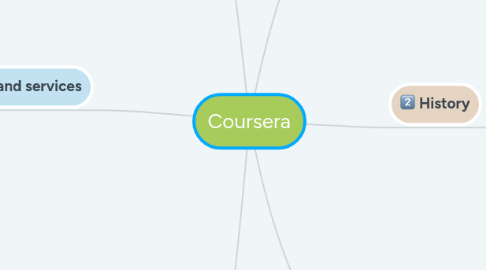
1. Strategic partners
1.1. February 2017
1.1.1. As of February 2017, the total number of partners is 149 across 29 countries.
1.2. Who does it work with?
1.2.1. Coursera mainly works with universities and colleges
1.2.2. but also with governments.
1.3. Institutions
1.3.1. University partners include University of São Paulo in Brazil, University of London in the UK, Indian School of Business of India, Yonsei University in Korea, and institutions like Yale and University of Pennsylvania.
2. Products and services
2.1. Courses
2.1.1. Structure
2.1.1.1. Coursera courses last approximately four to ten weeks, with one to two hours of video lectures a week.
2.1.1.2. These courses provide quizzes, weekly exercises, peer-graded assignments, and sometimes a final project or exam
2.1.2. Style
2.1.2.1. Courses are also provided on-demand
2.1.2.1.1. in which case users can take their time in completing the course with all of the material available at once.
2.1.2.1.2. As of May 2015 Coursera offered 104 on-demand courses.
2.1.3. Professional ed
2.1.3.1. As of 2017 Coursera offers full master's degrees.
2.1.3.1.1. Beginnings
2.1.3.1.2. They have moved on to offer Master of Computer Science in Data Science and Master of Business Administration (iMBA), both from University of Illinois.
2.2. Business model
2.2.1. Users statistics
2.2.1.1. As of February 2017, Coursera had 24 million registered users signed up for its programs, and offered more than 2,000 online courses
2.2.2. Earnings
2.2.2.1. In September 2013, it announced it had earned $1 million in revenue through the sale of verified certificates that authenticate successful course completion.
2.2.3. Free-based courses
2.2.3.1. Coursera first rolled out a series of fee-based course options
2.2.3.1.1. They include verified credentials for completion, in 2013
2.2.4. Venture capital
2.2.4.1. As of October 2015, the company had raised a total of $146.1 million in venture capital
2.2.5. No more free courses
2.2.5.1. In January 2016, Coursera rolled out fees to earn grades and assessment for “the vast majority of courses that are part of Specializations.”
2.2.5.2. The company offers Financial Aid to people who demonstrate a need
3. Characteristics
3.1. Type of site
3.1.1. Online education
3.2. Available in
3.2.1. English, Hindi, Spanish, French, Chinese, Arabic, Russian, Portuguese, Turkish, Ukrainian, Hebrew, German, Italian
3.3. Headquarters
3.3.1. Mountain View, California
3.4. Founder(s)
3.4.1. Andrew Ng and Daphne Koller
3.5. Key people
3.5.1. Jeff Maggioncalda (CEO)
3.6. Employees
3.6.1. 280 (June 2018)
3.7. Website
3.7.1. www.coursera.org
3.8. Alexa rank
3.8.1. 642 (April 2018)
3.9. Commercial
3.9.1. Yes
3.10. Registration
3.10.1. Required
3.11. Release
3.11.1. April 2012
3.12. Current status
3.12.1. Active
4. What is Coursera?
4.1. Coursera is an online learning platform founded that offers courses, specializations, and degrees.
4.2. Founders
4.2.1. Stanford professors Andrew Ng and Daphne Koller
4.3. How does it work?
4.3.1. Coursera works with universities and other organizations to offer online courses, specializations, and degrees in a variety of subjects
4.3.1.1. Engineering, humanities, medicine, biology, social sciences, mathematics, business, computer science, digital marketing, data science, and others.
4.4. Statistics
4.4.1. As of June 2018, Coursera had more than 33 million registered users and more than 2,400 courses.
5. History
5.1. Coursera was founded in 2012 by Stanford University computer science professors Andrew Ng and Daphne Koller.
5.2. Ng and Koller were inspired by their experiences offering their Stanford courses online in fall 2011, and soon after left Stanford to launch Coursera
5.2.1. Universities
5.2.1.1. Princeton, Stanford, the University of Michigan and the University of Pennsylvania were the first universities to offer content on the platform.
5.2.2. Offerings
5.2.2.1. Offerings have since expanded to include Specializations
5.2.2.1.1. These are collections of courses that build skills in a specific subject.
5.2.2.1.2. As well as degrees and a workforce development product for businesses and government organizations.
6. Funding
6.1. Beginnings
6.1.1. The startup raised an initial $16 million funding round.
6.1.1.1. Backed by Kleiner Perkins Caufield & Byers and New Enterprise Associates.
6.2. Earnings
6.2.1. In 2013, the World Bank Group led the Series B investment, which totaled $63 million.
6.2.2. In 2015, EDB Investments led the Series C round of venture funding, which totaled more than $60 million.
6.2.3. The company has secured $146.1 million in funding to date.
